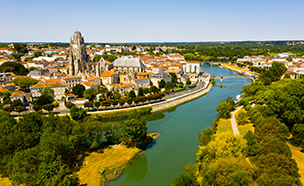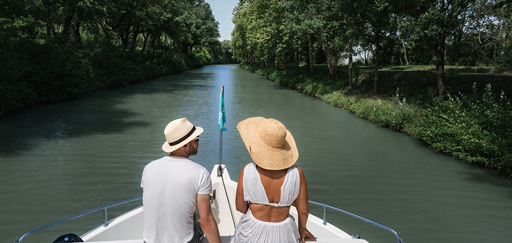Our friend Jean-François Macaigne tells of the ups and downs of his trip in a canal barge on the Sâone, from Scey to Besançon : recollections and advice from a devotee of France’s canals.
At Scey-sur-Saône, a three-cabin canal barge is waiting us. But there are only three of us: a couple of friends have pulled out at the last minute. The canal boat seems almost too big for us. The surface of the water is smooth, everything is calm. The next morning at dawn, just after the lock, we enter the St Albin tunnel, a magical place, shimmering with tints of orange. There then follows a water pathway between two stone walls. We pass by Rupt-sur-Saône, its castle and domed church, so typical of Franche-Comté. We tie up so that we can spend a little time strolling and walking through its steeply-sloping back streets.
After that the Saône presents us with a long cruise between meadows and hedged fields … and lots of locks. But all you need is to keep cool and collected and you get through in the end! On the right the castle of Ray-sur-Saône looms up. If you want to go and visit it, you have to moor in the little backwater, being careful not to run aground on the sand. Shortly afterwards it’s underground again, this time in the Savoyeux Tunnel. By evening we are facing the island of Le Carrosse, as the sun goes down over the calm waters of the river. There is not a sound and not a wave. The next day, we get a rude awakening from a fisherman complaining that “we’ve moored in his favourite spot”. We start the motor and go as far as Seurre, where we have breakfast. A little further on and we’re passing through Gray, which has some superb Renaissance buildings… and a supermarket that is very useful for taking on supplies!
After Mantoche and Pontailler, the Saône just strolls along, becomes wider and takes a trip through the woods. Further still and the double mushroom of the two water towers tells us that we’re approaching Auxonne, famous among boatmen for its needle dam. Here we gaze in wonder at the old castle and its tower, built on the orders of Louis XI to keep an eye on the nearby Burgundians. Two hours downstream, you have to keep your eyes peeled so as not to miss the entrance to the Rhône-Rhine Canal which will take us as far as Dôle and Besançon. The next day we start up the engine early, pass through the lock and, all of a sudden, there is a forest of pipes, a veritable concerto in ducts and tanks: the Solvay Chemical Factory. It fades into the distance, but the image stays fixed in our eyes.
We pass by Choisey and a few beautiful houses until we reach Dôle. The harbour is at the end, beneath a medieval tower. The tanners’ quarter is right by the riverside. On the landing-stages there are a few restaurants, making it look a little like Venice. From Dôle, it takes two days to get to Besançon. We pass by the bulb-shaped steeple of the church in Baverans, and then there is a succession of long reaches, some canal, some river. The landscape is green, varied: there are little cliffs, sometimes topped by houses with pointed roofs after a series of weirs. We reach the Thoraise tunnel. As we emerge from it, the Doubs valley widens between two hills. We continue our progress into the sublime and suddenly, in front of us, there looms up an impressive wall on top of the mountain: our first sight of the citadel of Besançon. Then we finally arrive at the new harbour for the City of Arts and Culture, where the Locaboat. base has been established. All we have to do now is to tie up and set off to explore the birthplace of Victor Hugo and the Lumière brothers. Our holiday is almost at an end; it really has been too short.

















![Home_GB[1]](https://www.locaboat.com/wp-content/uploads/2025/02/Home_GB1.png)



